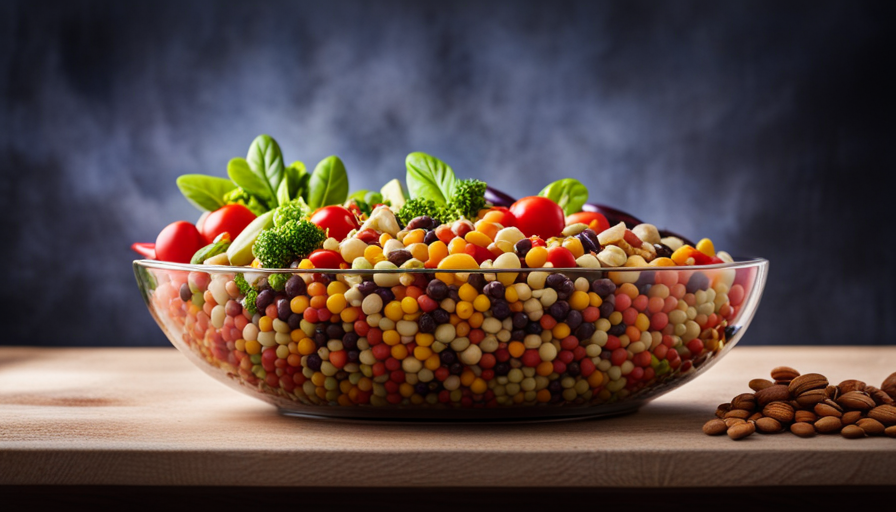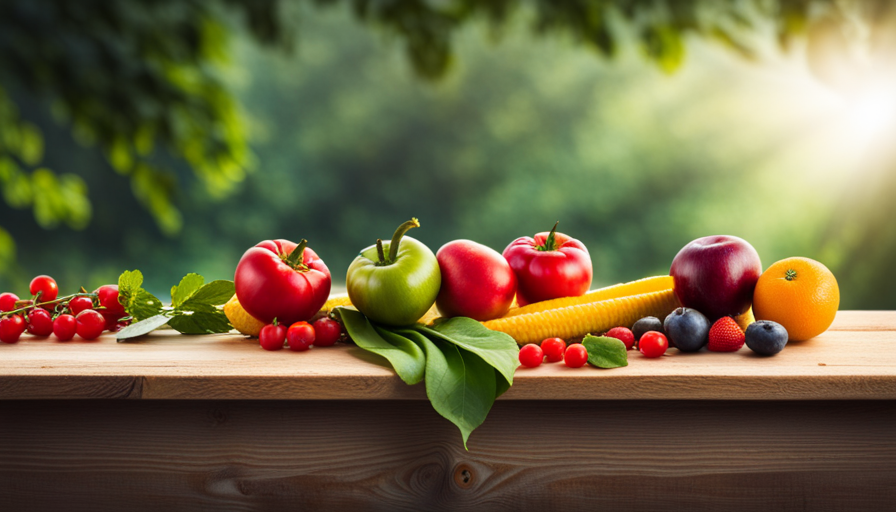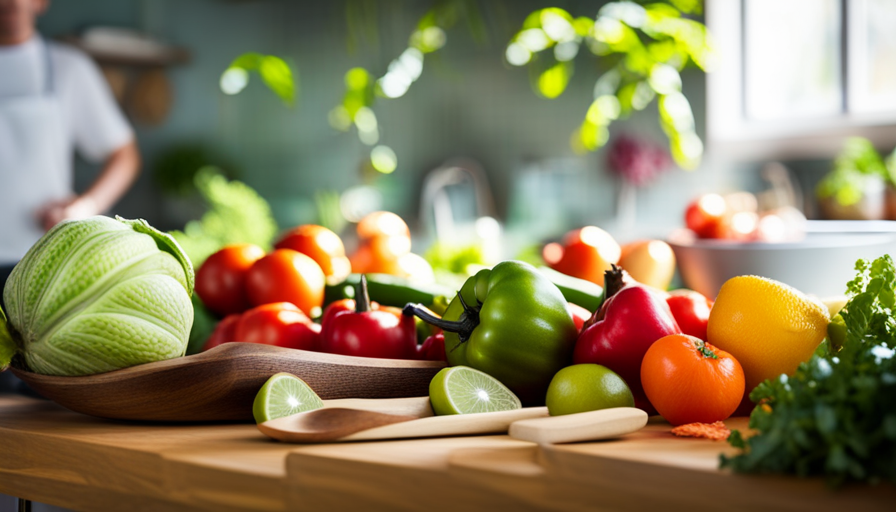Were you aware that adopting a diet based on raw foods could enhance your health and energy levels? Research published by the American Journal of Clinical Nutrition indicates that people adhering to a raw food diet experience decreased cholesterol and blood pressure levels, which lowers their chances of developing heart disease.
If you’re looking to make a positive change in your life and transition to a raw food diet, this article is for you. Transitioning to a raw food diet involves understanding the principles and benefits, incorporating more fruits and vegetables into your meals, exploring raw food preparation techniques, finding quality ingredients, and overcoming challenges.
By listening to your body’s needs and seeking support, you can successfully maintain a balanced and sustainable raw food diet. Get ready to embark on a journey towards improved health and well-being with these practical tips and evidence-based advice.
Key Takeaways
- Gradually incorporate more raw foods into meals and listen to your body’s needs
- Plan meals and include a variety of colors and types of fruits and vegetables
- Explore raw food preparation techniques and recipes to maximize nutrient intake
- Find local, organic ingredients for maximum nutritional benefits and consider joining community-supported agriculture for budget-friendly options
Understanding the Principles of a Raw Food Diet
If you’re ready to make a positive change in your eating habits, it’s time to dive into the principles of a raw food diet! Understanding the benefits of a raw food diet and how to transition to it is essential for your success.
A raw food diet is based on the principle of consuming unprocessed and uncooked foods. By eating raw fruits, vegetables, nuts, and seeds, you provide your body with a plethora of nutrients, enzymes, and antioxidants. These are essential for optimal health, as they support digestion, boost immunity, and promote overall well-being.
To transition to a raw food diet, start by gradually incorporating more raw foods into your meals. Begin by adding a raw salad or fresh fruit to each meal, and gradually increase the portion sizes over time. This will help your body adjust to the new way of eating.
It’s also important to listen to your body and pay attention to how you feel after each meal. Experiment with different raw food recipes and find what works best for you. Remember to stay hydrated, as raw foods have a high water content.
With patience and determination, you can successfully transition to a raw food diet and reap the numerous health benefits it offers. So start incorporating more raw foods into your meals today and embark on your journey to a healthier lifestyle.
Benefits of a Raw Food Diet for Health and Vitality
By embracing a lifestyle centered around vibrant, unprocessed nourishment, you can harness the saying ‘you’re what you eat’ to rejuvenate your health and invigorate your vitality.
Transitioning to a raw food diet can offer numerous benefits, including weight loss and improved skin health. One of the main reasons people choose a raw food diet is for weight loss. Raw foods are typically low in calories and high in fiber, which can help you feel fuller for longer and reduce overall calorie intake. Additionally, raw foods are rich in enzymes that aid in digestion and metabolism, further supporting weight loss efforts. Studies have shown that those following a raw food diet tend to have lower body mass indexes (BMIs) and reduced body fat percentages.
Another benefit of a raw food diet is its positive impact on skin health. Raw foods are packed with antioxidants, vitamins, and minerals that promote a healthy complexion. These nutrients help to combat free radicals, reduce inflammation, and support collagen production, leading to clearer, smoother, and more radiant skin. Many individuals who’ve adopted a raw food diet have reported improvements in acne, eczema, and other skin conditions.
Incorporating a raw food diet into your lifestyle can be a powerful tool for achieving weight loss and enhancing skin health. Remember to consult with a healthcare professional or nutritionist before making any drastic dietary changes, and enjoy the journey towards a healthier and more vibrant you.
Incorporating More Fruits and Vegetables into Your Meals
Embrace the vibrant colors and flavors of nature by infusing your meals with an abundance of fresh fruits and vegetables. Incorporating more fruits and vegetables into your meals not only adds variety, but also provides essential nutrients and antioxidants that contribute to your overall health and well-being.
Here are some practical tips to help you incorporate these nutritious foods into your daily diet:
-
Meal planning: Take some time each week to plan your meals and snacks. Include a variety of fruits and vegetables in your plan, ensuring that you have a good mix of different colors and types. This will not only make your meals visually appealing, but also provide a wide range of nutrients.
-
Superfoods: Incorporate superfoods into your meals to boost their nutritional value. Superfoods like kale, spinach, berries, and avocados are packed with vitamins, minerals, and antioxidants. Add them to your salads, smoothies, or stir-fries for an extra nutrient punch.
-
Get creative: Experiment with different cooking techniques and recipes to make fruits and vegetables more enjoyable. Roast vegetables with a sprinkle of olive oil and sea salt, blend fruits into a refreshing smoothie, or make a colorful salad with a variety of vegetables and a delicious homemade dressing.
By following these tips, you can easily incorporate more fruits and vegetables into your meals, making your transition to a raw food diet more enjoyable and nutritious.
Exploring Raw Food Preparation Techniques
Discover the endless possibilities of preparing delicious and nutrient-rich meals through the exploration of raw food preparation techniques. When transitioning to a raw food diet, it’s important to understand the benefits and challenges associated with this lifestyle choice.
Raw food diets are known for their numerous health benefits. By consuming raw fruits and vegetables, you’re maximizing the intake of vitamins, minerals, and enzymes that can be lost through cooking. These nutrients are essential for maintaining optimal health and promoting a strong immune system. Additionally, raw food diets have been linked to weight loss, increased energy levels, and improved digestion.
However, transitioning to a raw food diet can pose some challenges. One of the main challenges is the need for careful planning and preparation. Raw food meals often require more time in the kitchen, as they involve soaking, sprouting, and dehydrating various ingredients. It’s also important to ensure that you’re consuming a balanced diet that includes a variety of fruits, vegetables, nuts, and seeds to meet your nutritional needs.
To overcome these challenges, it’s helpful to explore various raw food preparation techniques. These can include making delicious smoothies, raw soups, salads, and even raw desserts. Experimenting with different flavors and ingredients won’t only add variety to your meals but also make the transition to a raw food diet more enjoyable.
By incorporating raw food preparation techniques into your meals, you can experience the numerous benefits of a raw food diet. While there may be some challenges along the way, with proper planning and creativity, you can create delicious and nutrient-rich meals that’ll nourish your body and support your overall health. So, start exploring the world of raw food preparation and embrace a healthier way of eating!
Finding Quality Ingredients for a Raw Food Diet
When it comes to sourcing ingredients for your raw food lifestyle, you’ll be amazed to learn that over 90% of the nutrients in fruits and vegetables can be lost through cooking. That’s why finding local, organic ingredients for a raw food diet is crucial to maximize the nutritional benefits.
Start by exploring your local farmers’ market, where you can find a wide variety of fresh, seasonal produce. Local farmers often take pride in their organic farming practices, ensuring that you get the highest quality ingredients. Not only will you be supporting local businesses, but you’ll also reduce your carbon footprint by cutting down on transportation emissions.
If you’re on a budget, don’t worry! There are plenty of budget-friendly options for raw food ingredients. Look for sales and discounts at your local grocery store or consider joining a community-supported agriculture (CSA) program. CSA programs allow you to receive a box of fresh, organic produce directly from local farmers at a discounted price. You can also save money by buying in bulk and freezing excess ingredients for later use.
Remember, when sourcing ingredients for a raw food diet, it’s important to prioritize freshness, quality, and organic options whenever possible. By doing so, you’ll be able to fully enjoy the health benefits of a raw food lifestyle.
Creating Delicious and Nutritious Raw Food Recipes
Now that you’ve found quality ingredients for your raw food diet, it’s time to dive into the exciting world of creating delicious and nutritious raw food recipes. Don’t worry, it’s easier than you think! With a little creativity and some basic knowledge, you can whip up quick and easy raw food meals that’ll leave your taste buds satisfied and your body nourished.
One key aspect of creating raw food recipes is incorporating superfoods. These’re nutrient-dense foods that provide a wide range of health benefits. Some popular superfoods include kale, spinach, blueberries, chia seeds, and hemp seeds. By adding these ingredients to your raw food meals, you can enhance their nutritional value and boost your overall health.
When it comes to creating raw food recipes, simplicity’s often the key. Many raw food meals require minimal preparation and can be made in a matter of minutes. You can start by making refreshing salads with a variety of fresh vegetables, fruits, and herbs. You can also experiment with making raw food wraps using lettuce leaves or collard greens as a base and filling them with your favorite raw veggies and sauces.
Remember, the goal of a raw food diet’s to consume food in its most natural state, so try to avoid cooking or heating your ingredients. With a little practice and experimentation, you’ll soon discover a whole new world of flavors and textures that’ll make transitioning to a raw food diet an enjoyable and fulfilling experience.
Overcoming Challenges and Sticking to a Raw Food Lifestyle
Although it may seem challenging at first, sticking to a raw food lifestyle can lead to long-term health benefits. It’s normal to experience cravings for cooked or processed foods, but there are strategies to overcome them.
Here are some tips for dealing with cravings:
-
Distract yourself: When a craving hits, engage in a distracting activity such as going for a walk, reading a book, or practicing a hobby. This can help take your mind off the craving and reduce its intensity.
-
Opt for healthy alternatives: Find raw food substitutes for your favorite cooked dishes. For example, you can make zucchini noodles instead of pasta or create raw desserts using dates and nuts.
Dealing with social situations can also be a challenge when following a raw food lifestyle. Here’s how to handle them:
-
Communicate your dietary choices: Let your friends and family know about your decision to follow a raw food diet. Educate them on the health benefits and explain that you appreciate their support.
-
Bring your own raw food dishes: When attending gatherings or events, offer to bring a raw food dish to share. This ensures you have something to eat and introduces others to delicious raw food options.
Remember, transitioning to a raw food lifestyle takes time and patience. By implementing these strategies, you can overcome cravings and navigate social situations while sticking to your raw food journey.
Listening to Your Body’s Needs on a Raw Food Diet
Embrace the natural rhythm of your body and let it guide you on your journey to vibrant health and vitality. When transitioning to a raw food diet, it’s important to listen to your body’s needs. Your body’s unique, and it knows what it requires to thrive.
Listening to your body’s needs on a raw food diet means paying attention to its signals and responding accordingly. It’s essential to tune in to your hunger cues and eat when you’re truly hungry. This’ll ensure that you’re providing your body with the nourishment it requires.
Additionally, listen to your body’s cravings. Cravings can be a sign of nutrient deficiencies, so it’s important to address them by incorporating a variety of fruits, vegetables, nuts, and seeds into your diet.
Another aspect of listening to your body’s needs is being aware of how different foods make you feel. Pay attention to how your body reacts to certain foods and adjust your diet accordingly. For example, if you notice that certain foods cause digestive distress or low energy levels, it may be a sign that those foods don’t agree with your body. Experiment with different foods and find what works best for you.
Transitioning to a raw food diet requires listening to your body’s needs. By tuning in to your hunger cues, addressing cravings, and being aware of how different foods make you feel, you can create a diet that supports your overall health and well-being. Trust your body’s wisdom and let it be your guide on this transformative journey.
Seeking Support and Resources for a Successful Transition
Finding the right support and resources is crucial for a successful shift towards a nourishing and vibrant lifestyle. When transitioning to a raw food diet, having a strong support system can make all the difference in maintaining motivation and staying on track.
One great way to find support is by joining local or online support groups that are specifically catered to individuals following a raw food lifestyle. These groups can provide a sense of community, allowing you to connect with others who share similar goals and experiences. Additionally, being part of a support group can provide you with a network of people who can offer guidance, share recipes, and provide encouragement during challenging times.
In addition to support groups, online communities dedicated to raw food diets are a valuable resource for anyone looking to transition successfully. These communities often offer a wealth of information, including tips, recipes, and personal stories from individuals who’ve already made the switch. Participating in these online forums allows you to ask questions, seek advice, and gain insights from experienced raw food enthusiasts. Moreover, online communities provide a platform for you to share your own journey and connect with like-minded individuals from all over the world.
By seeking out support groups and online communities, you’re surrounding yourself with a network of people who can offer guidance, inspiration, and motivation throughout your transition to a raw food diet. Remember, you don’t have to go through this journey alone, and with the right support, you can create a sustainable and nourishing lifestyle.
Maintaining a Balanced and Sustainable Raw Food Diet
Maintaining a balanced and sustainable raw food lifestyle requires dedication, mindful choices, and a deep commitment to nourishing your body with vibrant, living foods.
One important aspect of maintaining this lifestyle is balanced meal planning. It’s essential to ensure that you’re getting all the necessary nutrients from a variety of sources. Include a mix of fruits, vegetables, nuts, seeds, and sprouted grains in your meals to provide a range of vitamins, minerals, and antioxidants. Aim to have a balance of macronutrients, such as carbohydrates, proteins, and healthy fats, to support your overall health.
Managing cravings is another crucial aspect of maintaining a raw food diet. It’s natural to experience cravings, especially when transitioning from a diet high in processed foods. To overcome these cravings, try to identify the underlying causes. Are you feeling stressed, bored, or emotional? Finding alternative ways to cope with these emotions, such as practicing mindfulness or engaging in a hobby, can help divert your attention from cravings.
Additionally, make sure you’re incorporating enough variety and flavor into your meals. Experiment with different recipes, spices, and herbs to keep your taste buds satisfied.
Remember, maintaining a balanced and sustainable raw food diet is a journey. It’s important to listen to your body, adjust your meal plans as needed, and seek support from a qualified nutritionist or healthcare professional. With dedication and mindful choices, you can thrive on a raw food lifestyle while nourishing your body with the vibrant, living foods it craves.
Frequently Asked Questions
What are the potential risks or drawbacks of transitioning to a raw food diet?
When transitioning to a raw food diet, it’s important to be aware of the potential health risks and drawbacks. Some people may experience nutrient deficiencies, as certain vitamins and minerals are better absorbed when cooked.
Additionally, maintaining a raw food diet long term can be challenging due to limited food options and social restrictions. It’s crucial to plan your meals carefully to ensure you’re getting all the necessary nutrients and to consult with a healthcare professional to ensure long-term sustainability.
Can a raw food diet meet all of my nutritional needs?
Yes, a raw food diet can meet all of your nutritional needs. Contrary to popular belief, raw food diets can provide a wide range of essential nutrients. Fruits, vegetables, nuts, and seeds are packed with vitamins, minerals, and antioxidants that support your overall health.
Additionally, raw foods retain their natural enzymes, which aid in digestion. By incorporating a variety of plant-based foods, you can enjoy the benefits of a raw food diet while ensuring you meet your nutritional requirements.
How can I ensure I am getting enough protein on a raw food diet?
To ensure protein intake on a raw food diet, focus on plant-based protein sources. Foods like nuts, seeds, legumes, and leafy greens are excellent options. For example, almonds, sunflower seeds, and lentils are all high in protein.
Incorporate these into your meals and snacks to meet your protein needs. It’s also a good idea to vary your protein sources to ensure you’re getting a balanced amino acid profile.
Are there any specific food safety concerns I should be aware of when consuming raw foods?
When following a raw food diet, it’s crucial to be aware of potential food safety concerns. Raw foods can carry harmful bacteria like E.coli and Salmonella, so proper handling and storage are essential.
Wash all produce thoroughly and avoid cross-contamination by using separate cutting boards for raw meat and vegetables.
Additionally, be cautious when consuming raw eggs or unpasteurized dairy products.
By taking these precautions, you can safely enjoy the benefits of a raw food diet.
Can I still enjoy social events and dining out while following a raw food diet?
When following a raw food diet, socializing challenges may arise, but they can be overcome with some tips.
While dining out, look for restaurants that offer raw food options or those willing to accommodate your preferences. Call ahead to inquire about their menu and ask for modifications if needed.
When attending social events, bring a raw food dish to share or eat beforehand to ensure you have suitable options available.
Communication and planning are key to enjoying social events and dining out while adhering to a raw food diet.
Can I Transition to a Raw Food Diet on My Own, or Do I Need Certification as a Raw Food Nutritionist?
Transitioning to a raw food diet can be done on your own, but consulting with a certified raw food nutritionist can provide valuable guidance. Their expertise can ensure that you meet your nutritional needs and help you navigate potential challenges of the diet. Consulting with a certified raw food nutritionist can make your transition smoother.
Conclusion
Congratulations on completing the journey towards a raw food diet! You’ve embraced the principles, reaped the benefits, and learned how to prepare delicious meals.
But here’s the ironic truth: it’s not always easy. Yes, challenges will arise, and sticking to this lifestyle can be tough. But remember, the key is to listen to your body’s needs and seek support when needed.
Stay balanced, sustainable, and don’t forget to enjoy the journey. You’ve got this!










